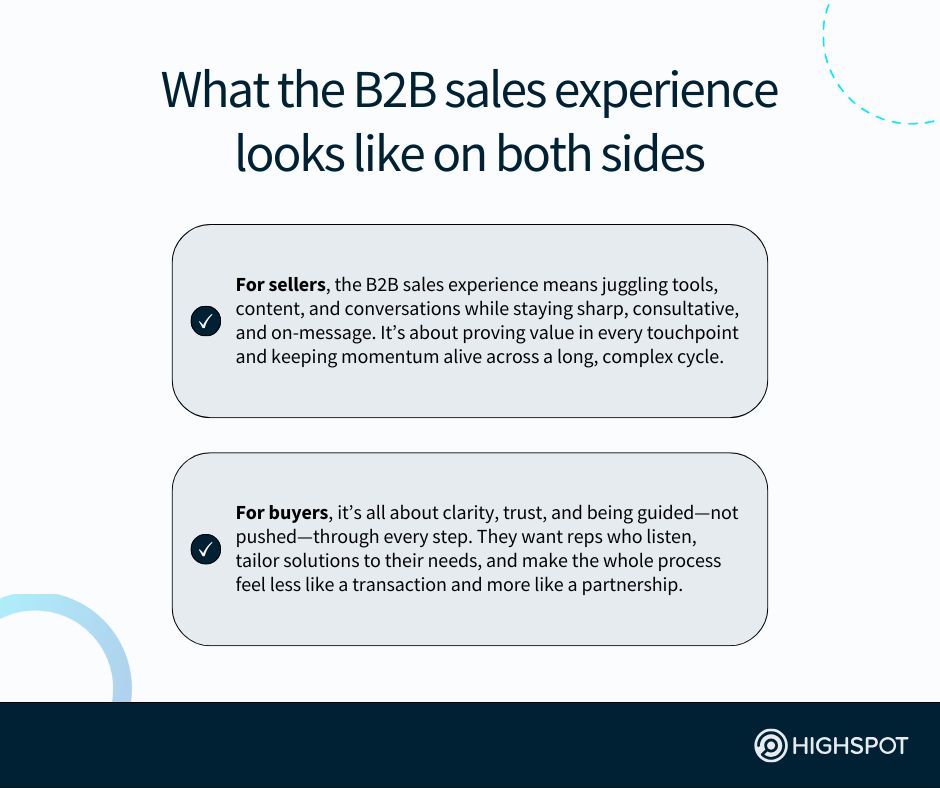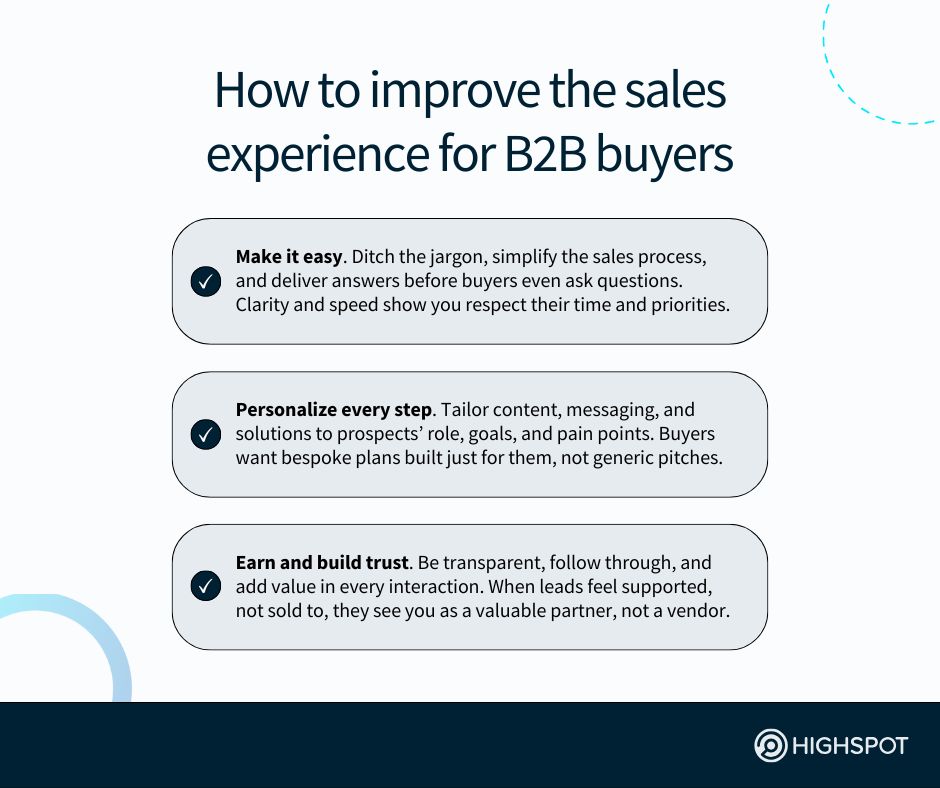Key Takeaways
- The B2B sales experience shouldn’t feel like a scavenger hunt. Reps need smart tools, real-time content, and role-based guidance so they can show up like professionals in every single buyer conversation.
- By simplifying steps, eliminating redundant tools, and building in coaching where it counts, sales managers can give their reps the clarity and confidence to drive conversions consistently and at scale.
- Relationship-building is a muscle every salesperson needs to succeed. Train your reps to listen, personalize, and follow through like it matters—because it does. Consistency wins trust. Trust wins deals.
The modern B2B sales experience is an exhaustive (and sometimes exhausting) process for both sellers and buyers today. It’s filled with long sales cycles, multiple stakeholders, lots of back-and-forth, and too many disconnected processes.
Sales representatives try to juggle various competing demands, while prospects too often suffer through lengthy pitches and delayed (or no) follow-ups.
It’s no surprise, then, that both parties want the same thing: Sales professionals and potential customers they engage want a smoother B2B sales experience.
This only happens, though, when sales teams like yours focus on developing soft skills, integrating proven selling tools, and implementing practical strategies that align with customer needs and deliver value at every stage of the sales funnel.

The B2B sales experience, explained
The B2B sales experience refers to every touchpoint go-to-market teams have with potential customers across the B2B buying journey: from lead generation and qualification, to post-sale support and contract renewal and expansion.
An effective and impactful B2B sales experience is shaped by every email, call, meeting, follow-up, and resource a rep delivers to prospects in their efforts to provide valuable insights and recommendations to and build relationships with buyers.
A strong B2B sales experience establishes trust, reduces any deal friction, and makes it easy for leads to make purchasing decisions on their own timeline.
- For reps, it means having the tools, training, and data-driven insights to show up prepared, confident, and consultative in all selling moments. They must be equipped to address customer needs and guide them through the sales cycle.
- For potential clients, a stellar B2B sales experience is one in which the sales process feels seamless, personalized, and worth their investment of time and budget. They don’t feel like reps are selling products but rather solutions.
One way many sales organizations at B2B businesses are better personalizing the experience for buyers is using AI for sales—specifically, tools that help unearth the right messaging and content that is most likely to resonate with leads, based on their needs, feedback, and general activity.
“As AI adoption grows, enablement teams can leverage it more strategically—from enhancing decision-making to creating personalized buyer experiences—to empower go-to-market effectiveness and alleviate their top business challenges,” Highspot’s State of Sales Enablement Report 2025 indicated.
Find out how Ritchie Bros. leverages Highspot to personalize the B2B sales experience for its prospects and customers using our AI-powered sales enablement platform for GTM teams.
Industry trends about modern B2B sales
Not long ago, B2B sales entailed mostly face-to-face meetings, phone calls, and product pitches. Sales reps built their books of business through persistence and handshakes. Buyers made decisions faster, often influenced by one or two leaders.
While that model once worked, today everything looks different.
Based on how organizations in financial services, manufacturing, life sciences, and other industries sell today, modern B2B sales means dealing with:
- Longer sales cycles: Market trends and cautious purchase decisions extend the timeline, yet, buyers expect the same level of speed from reps.
- Involving multiple stakeholders: A buyer might need approval from IT, legal, and procurement before signing off. Each new stakeholder adds questions, proof points, and conversations throughout the decision-making process.
- Complex solutions: Buyers expect tailored solutions and continuous improvement through regular updates and communication after the deal. A software vendor might sell licenses, but success comes down to onboarding, training, and easy-to-access post-sale support.
- Cross-functional collaboration: Sales leaders need marketing teams to generate quality over volume—qualify, score, and deliver real buyers, while customer success must nurture new customers to ensure renewals and upsells. When these functions are misaligned, potential customers feel the friction and leave for the competition.
- Industry trends: Market research and evolving regulations delay decisions. While some of these extra checks protect buyers, they do slow down the sales cycle. For example, cybersecurity requirements force many buyers to add compliance checks mid-funnel.
- Sales technology dependence: Today’s sales model relies on CRMs, AI analytics, and B2B sales enablement platforms. Without integration, sales reps waste hours switching contexts instead of building client relationships. In fact, Highspot’s How to Streamline Your Sales Process guide found 66% of sales teams say they are drowning in too many tools, which makes it harder to deliver a consistent buyer experience.
The experience is just as dramatic for buyers. Instead of waiting for a rep to deliver all the information, they now come to the table already armed with research, competitor comparisons, and defined expectations.
A 2024 6sense report found 80% of B2B buyers don’t even reach out until they’re about 70% through their buying journey. They want the solution to map to their unique needs from the start—and you lose them quickly with one-size-fits-all pitches.
That means the decision-making process is also rarely straightforward.
Buyers compare multiple vendors, scrutinize past deals for lessons learned, and expect clear negotiations from sales reps. These buying teams are prepared. The final selection is about trust and confidence that the vendor can provide ongoing support long after the contract is signed.
Imagine a procurement manager narrowing down three vendors after weeks of research. The IT team wants integration assurance, compliance insists on proof of data protection protocols, and finance demands proven impact on revenue.
By the time the decision is made, it isn’t the flashiest pitch that wins. It’s the sales team that demonstrates they understand the nuances and intricacies of the prospect’s problem and has shown they will provide continuous support.
| B2B sales experience FAQ | Answer |
|---|---|
| How can new sales reps deliver a top-tier buying experience from Day 1? | Onboard tech with AI-powered training, role play, just-in-time guidance, and next-best actions directly into reps’ daily workflow. Give sellers prescriptive plays by buyer type, deal stage, and product. Reinforce behavior with practice, micro-coaching, and real-time feedback so they show up sharp, even if they’re green. |
| How can we analyze buyer signals to improve rep prospecting and selling? | Track how buyers interact with pitches, meetings, digital sales rooms, and rep follow-ups. Use that data to refine your personas, target high-intent accounts, and improve message-market fit. Enable reps with real-time insights into what content and messaging lands and what loses buyer attention. |
| How do we manage long, complex sales cycles without losing momentum? | Break the deal into structured stages with clear objectives and tailored plays by decision-maker. Use CRM-integrated guidance, recurring value-adds, and buyer engagement analytics to track deal velocity and momentum. Keep potential customers focused by consistently aligning to their evolving objectives and needs, not just your product roadmap or quarterly revenue goals. |
| What’s the best way to navigate sales deals with several decision-makers? | Create a stakeholder map early and identify each buyer’s pain points, priorities, and level of influence. Use persona-specific content, messaging, and playbooks to address individual concerns, but anchor everything to a shared strategic outcome the business wants to ultimately achieve. Track engagement across the group in real-time to spot gaps and alignment issues fast. |
| How can reps deeply tailor solutions to the specific needs of each prospect? | Train your sales reps to diagnose before pitching so they actively listen for strategic pain instead of surface-level asks. Use cutting-edge AI sales tools to recommend deal-stage-specific plays, tailored decks and presentations, and buyer-specific case studies. Ensure each touchpoint ties directly back to the buyer’s metrics and decision-making priorities. |
| How do we keep buyers actively engaged during a long evaluation process? | Use prospect engagement data to deliver new insights, content, or product POVs, based on where the buyer is in their respective buying journey. Replace static follow-ups with interactive touchpoints like digital sales rooms, executive summaries, or ROI snapshots to re-spark urgency. Ensure reps follow up with leads on a regular cadence on buyers’ preferred channels. |
| Which tools deliver a strong B2B sales experience for buyers and sellers? | Prioritize solutions that support in-the-moment selling, AI-powered search for content discoverability, guided learning paths, and digital collaboration spaces. If a tool doesn’t reduce friction in the sales process or improve personalization with reps’ outreach efforts, it’s likely just adding admin work for sellers. Streamline to a few high-impact, integrated systems. |
| How can we replicate what our top sellers do at scale across our sales team? | Use sales rep scorecards and real-time meeting intelligence to pinpoint which behaviors, content, and actions drive tangible business results and revenue growth. Package those into guided plays, learning paths, and automated suggestions for sellers. Make excellence repeatable with real-world benchmarks and proactive coaching at the team and individual level. |
| How do we ensure reps apply what they’ve learned in training and coaching? | Tie reps’ learning during sales training sessions to execution in deal discussions with prospects. Use leading AI tools, like sales enablement platforms, to surface content and skill reminders when reps need them: in a meeting, in the CRM, in email. Reinforce key skills through ongoing sales role play, feedback loops, and performance data reviews so reps understand how to grow. |
| How can we help our sales reps guide buyers without rushing them to close? | Coach reps to align with buying stages, not sales quotas. Use deal health metrics and engagement signals to guide pacing. Teach reps to ask better discovery questions and co-build timelines with buyers, so they drive urgency through clarity and don’t inadvertently pressure prospects to make quick decisions. Drive home the importance of patience in B2B sales cycles. |
How to improve the B2B sales experience
With so many moving parts, it’s easy for the sales experience to break down. At the same time, small, intentional changes can make a big difference today.
The following 10 B2B sales strategies are designed to be practical and deliver more value at every stage of the buying journey so your reps can more capably and efficiently convert other businesses into new, high-paying clients.
Streamline the lead-generation-to-qualification process
Not all potential customers are ready or worth a rep’s time. Streamlining qualification improves sales efficiency by preventing wasted effort and ensuring buyers get timely, relevant engagement.
This typically happens at the very top of the sales funnel, where marketing and SDR teams assess inbound leads based on firmographics, behaviors, and intent before routing them to sales.
With the right sales enablement tools, that process continues deeper in the funnel where reps can see which buyers are actually opening content, engaging in discovery calls, or inviting other stakeholders into the conversation.
Many teams apply consultative selling frameworks like MEDDIC to keep deals from stalling. This way, reps spend more time on opportunities with momentum and less on prospects who are unlikely to convert.
Personalize every single interaction with qualifying leads
Buyers can sense a copy-and-paste pitch instantly. Personalization signals to buyers that their unique needs are not just another checkbox in a generic pitch.
With buying councils replacing single decision-makers, reps must tailor their conversations and content to multiple stakeholders with different priorities.
PitchBook faced this exact challenge as its sales cycle shifted from selling to individual users to engaging entire buyer councils, including executives who were often unreachable through traditional channels.
By building buyer persona-specific Sales Plays and leveraging digital sales rooms to personalize content for every stage and stakeholder, PitchBook drove a 20% increase in buyer engagement and $2.2M in influenced revenue.
Offer multiple stakeholders an omnichannel experience
Today’s customers engage across an average of ten interactive channels, including email, in-person meetings, procurement portals, web chat, and more.
Specifically, they expect consistency in every interaction. That’s why sales leaders must ensure messaging is on point and materials are relevant across touchpoints.
When reps know exactly which channels buyers are engaging with, they can focus their time where it matters most.
Match messaging to each particular sales cycle stage
A streamlined sales process meets buyers where they are. Awareness-stage prospects want market research and industry trends, evaluation-stage buyers want vendor comparisons, and decision-stage buyers expect transparent pricing and solutions made for them.
DocuSign equips its field team with a single source of truth, with the right content and training at just the right moment. Reps spend less time searching for appropriate materials. Their sales cycles have reduced by 10% and they’ve increased average deal size by 20%.
This kind of alignment between funnel stage and sales activity shows customers that you’re paying attention to them and not overwhelming them with cookie-cutter messaging.
Align go-to-market teams around buyer pain points
When marketing, sales, and customer success teams operate in silos, buyers experience inconsistent messaging and fragmented engagement, while internally, reps struggle with conflicting priorities and unclear ownership.
Alignment requires a unified platform and a common set of goals because while sales may own the conversation, buyers experience every team they interact with as part of one brand.
Amwell initially had an enablement platform only for product marketing, leaving much of the sales organization without access to resources. By centralizing all training, communications, and sales playbooks, Amwell now has a single source of truth that spans the entire revenue organization.

Build an effective sales training and coaching program
Even the best reps need support. Ongoing training, whether it’s product updates, objection handling, or role-playing for tough calls, keeps your sales team sharp. Coaching should be tailored to individual skill strengths and gaps, not delivered as one-size-fits-all sessions.
Consider SS&C Intralinks. The company transformed its enablement efforts by embedding training and coaching directly into Highspot. Adoption of our solution by the organization’s sales force hit 100%, while training completion rates jumped by 75%. This helped its reps reinforce skills in real-world scenarios.
Reward relationship-building behaviors of top performers
Revenue matters, but so does everything that leads up to it. Recognizing reps for building client relationships, expanding into existing customer accounts, and gathering buyer feedback encourages the behaviors that inspire long-term partnerships.
An ITA Group report from 2025 found that 44% of sales reps consider non-financial recognition extremely important, and over 90% are more likely to engage in training or feedback loops when incentives are tied to them.
When leaders celebrate and reinforce these behaviors, they make it clear that success is measured not only by closed deals but also by the loyal customers who stick around.
Discover how PitchBook elevates the sales experience for both its sales representatives and potential customers during deal discussions using Highspot’s sales enablement solution for GTM teams.
Invest in a best-in-class, AI-powered sales enablement tool
Your tech stack should work for your team—not waste their time. AI-powered sales enablement tools cut friction, automate admin work, and surface the most relevant content.
Gartner found that since buyers spend only ~17% of their purchase time with suppliers, reps need to maximize every moment they have. That’s why reps need systems that guide them to the right actions instead of burying them in manual tasks.
When your CRM, enablement platform, and other GTM tools work together and sync data, you remove guesswork, empowering your reps to focus on building relationships, providing valuable advice, and providing a human sales experience.
Analyze what factors cause shorter and longer sales cycles
You can’t improve what you don’t measure. Metrics like conversion rates, deal velocity, content usage, and buyer engagement provide visibility into what’s working and what’s not.
For example, Loadstone placed native sales analytics tracking in its digital sales rooms and shares content so sellers can measure open rates, time spent, external shares, and inform future conversations.
The business saw conversion rates jump by 110% and win rates improve by 45%.
Ask for feedback to help reps close deals more efficiently
The easiest way to sharpen the sales experience is to ask. Reps can point out where tools or the sales approach fall apart, and buyers will tell you what slowed them down.
Collecting this feedback through surveys, deal reviews, or even quick check-ins turns small insights into meaningful improvements.
While feedback is easy to collect, acting on it is what truly improves the sales experience.
Ensure customer success is prepared for post-sale support
You worked hard to win the deal. Don’t let momentum die once the ink dries. Your customer wants confidence, not confusion, when they move from prospect to partner. That’s why a seamless hand-off to customer success is essential.
Set your customer success with the right context: what problems they’re solving, which outcomes they expect, and any landmines you uncovered along the way. Arm your CS team with the details so they can hit the ground running instead of playing detective trying to discover new clients’ goals and needs.
Elevating the B2B sales experience for buyers and sellers alike
Today’s go-to-market leaders must establish a successful sales process—one that’s scalable and repeatable—that ultimately balances needs tied to their sales strategy and is optimized using valuable insights derived from their GTM tech.
It’s clear: To succeed, your sellers need to liaise closely with your enablement and marketing teams to effectively guide buyers through complex decisions in a stakeholder-heavy journey, where customer satisfaction is the top priority because it directly impacts sales performance and repeat business.
Every interaction throughout shapes how the buying committee perceives your product’s unique value proposition and whether they move forward with a strategic partnership with your organization or move on to the competition.
The companies that win are those that use savvy, data-backed negotiation skills to turn buyer expectations into business opportunities and develop trusting, long-term relationships with clients. The financial health of your organization depends on the attention to detail of your sales team members.




